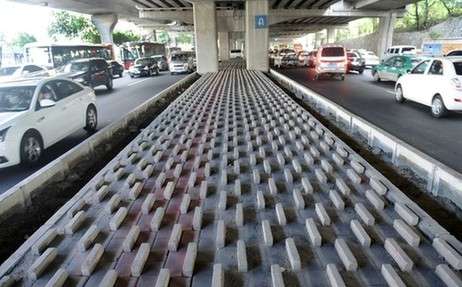當前位置: Language Tips> 流行新詞
分享到
天橋底下鋪滿了水泥柱讓無家可歸者無法棲身,公交站亭里的座椅太窄沒法久坐,這樣的公共建筑設計曾經讓不少人詬病,不過,據說這樣的設計就是為了阻止人們過度使用這些公共建筑的。因此,這些建筑也被人們稱為“不友好建筑”。

Have you ever stood at a bus shelter and longed to take the weight off your feet, only to be presented with the unpleasant prospect of some kind of metal contraption for leaning on? If you've then wondered how anyone could possibly get comfortable using it, then the answer is simply this – they're not supposed to. In a new wave of design, dubbed hostile architecture, aesthetics are not the only motivating factor when making choices about the form and fabric of particular constructions.
你是否曾經在某個公交站亭,想要坐下歇歇腳,卻發現只有一個造型詭異的金屬裝置可以倚靠一陣?你如果有過這樣的經歷,那么你可能會想,這樣的裝置人們用著怎么會舒服呢?答案是,人家本來就沒想讓你用。建筑設計界新近刮起一陣風,叫做“不友好建筑”,在選擇某個特定建筑的形式和材料的時候,美學已不是唯一的決定因素。
It highlights a wide architectural trend in which constructions in public spaces are incorporating design elements deliberately intended to stop people impacting on them. Examples include narrow, slanted bus shelter seats that are barely suitable for sitting on (and would be impossible for a homeless person to sleep on), benches with bulky armrests or protrusions which prevent people from reclining or sitting for long periods, jagged, irregular paved areas in order to deter skateboarders, bollards under bridges and flyovers to prevent skateboarding and sheltering, and studded window ledges which discourage people from sitting or lying down.
這種建筑風格的突出特征是公共場所的建筑會刻意結合一些阻止人們對其產生影響的設計因素。比如,不適宜落座(更不可能讓無家可歸者在上面睡覺的)狹窄且傾斜的公交站亭座椅,帶有笨重扶手或凸起部分、阻止人們斜靠或長時間落座的長凳,阻止輪滑愛好者的參差不齊、不規則鋪筑路面,為了阻止輪滑和尋求遮蔽行為而在橋梁和天橋下面鋪設的短柱,以及為了阻止人們落座或平躺而設計的布滿釘板的窗臺。
The expression hostile architecture has pejorative overtones, and is therefore mainly used by people who are skeptical about, if not completely opposed to, the idea. On the other hand, there's also the view that urban design has moved on from crude deterrents like metal spikes, and that more subtle design elements can be valuable in discouraging criminal or anti-social behavior. In these contexts, the same concept is often described as defensive or defensible architecture. (Source: macmillandictionary.com)
“不友好建筑”一詞帶有貶義,因此多由對這一理念抱有懷疑態度(如果不是完全反對的話)的人使用。從另一方面來看,有一種觀點認為城市設計已不再停留在使用金屬鋼釘等簡單粗暴的形式,而且這些精巧微妙的設計元素在阻止犯罪行為或反社會行為方面很有價值。在這種情況下,“不友好建筑”通常都被稱為“防御式建筑”。
(中國日報網英語點津 Helen)
上一篇 : 最牛“節能發型”!
下一篇 : 我不想看書!因為我有“密集恐懼癥”!
分享到
關注和訂閱


電話:8610-84883645
傳真:8610-84883500
Email: languagetips@chinadaily.com.cn